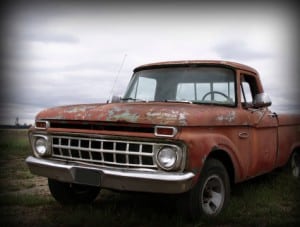 Rust:
Rust:
Grandpa James gets up every morning at the crack of dawn, same as he has for the past sixty-three years. He pulls on his overalls, his favorite yellow ball cap, and a pair of scuffed up leather boots. Then he clicks on the morning newscast while the coffee brews in the kitchen: nice day for a drive. With a coffee mug in his hand, and enough in the pot for Grandma Polly when she wakes up, Grandpa James heads outside to his old pickup truck. He kicks the front tires on his way around the vehicle, coming to a sudden stop as he nears the driver’s side door. Behind the front bumper is a rust spot – a splotchy pattern of orange and brown discoloring the mostly faded cobalt blue paint. He decides it’s as good a day as any to fix the problem, so Grandpa James heads into town for a bottle of rust converter.
Rust, otherwise known as iron oxide, is the natural result when water, oxygen, and iron are combined. It’s an example of corrosion and, left untreated, will completely dissolve iron and steel. The rust occurred when Grandpa James drove beside a semi-trailer on the highway. The trailer tires sent a large rock into the side of his truck, chipping the paint. Damage to the paint left the metal underneath exposed to the elements, and when it rained a few days later the corrosion process began. Once iron has been oxidized, it cannot be converted back to iron, but it can be treated.
Tannic Acid:
Tannic acid (Tannin) is derived from plants, and is commonly used in leather production and wood staining. It is also the main ingredient found in rust converters. When combined with iron oxide, tannic acid creates a more stable compound known as iron tannate. Though it won’t work on aluminum, copper, stainless steel, or galvanized metal it does wonders with iron and steel. Grandpa James doesn’t understand the science behind it all, but he knows he needs a bottle of rust converter. He climbs into his pickup, turns the key, and engages the transmission.
Meanwhile…
Grandma Polly pours her first cup of coffee and heads out onto the front porch where she grabs the paper and sits down at a small, white metal breakfast table. The morning is cool and she likes to hear the birds chirping. It makes the news go down easier…seems there isn’t any happiness to report anymore. She unfurls the paper and sips her coffee, setting it down in the same spot she has for eight years. What began as a few chips in the paint is now a missing chunk, and rust has formed. Grandma Polly decides it’s about time she fixed her little table.
Black Paint:
Rust converters generally include a polymer that acts as a protective layer on the affected iron or steel. The polymer and tannic acid combine with the iron oxide to create a black layer of iron tannate. (It looks a lot like black paint.) This newly formed compound is resistant to corrosion and can be painted over using oil or epoxy-based paints. In this case, Grandpa James uses a cobalt blue that matches the rest of his pickup truck, and Grandma Polly decides to repaint the table and chairs – choosing a bright yellow.
References and Additional Reading:
What are some other uses for tannic acid?





